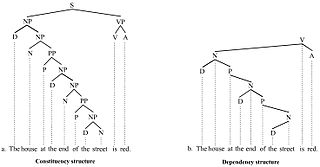Related Research Articles
Corpus linguistics is an empirical method for the study of language by way of a text corpus. Corpora are balanced, often stratified collections of authentic, "real world", text of speech or writing that aim to represent a given linguistic variety. Today, corpora are generally machine-readable data collections.
In linguistics and natural language processing, a corpus or text corpus is a dataset, consisting of natively digital and older, digitalized, language resources, either annotated or unannotated.
Word-sense disambiguation is the process of identifying which sense of a word is meant in a sentence or other segment of context. In human language processing and cognition, it is usually subconscious.

In linguistics, a treebank is a parsed text corpus that annotates syntactic or semantic sentence structure. The construction of parsed corpora in the early 1990s revolutionized computational linguistics, which benefitted from large-scale empirical data.
The British National Corpus (BNC) is a 100-million-word text corpus of samples of written and spoken English from a wide range of sources. The corpus covers British English of the late 20th century from a wide variety of genres, with the intention that it be a representative sample of spoken and written British English of that time. It is used in corpus linguistics for analysis of corpora.
Linguistic categories include
The International Corpus of English (ICE) is a set of text corpora representing varieties of English from around the world. Over twenty countries or groups of countries where English is the first language or an official second language are included.
The Corpus of Contemporary American English (COCA) is a one-billion-word corpus of contemporary American English. It was created by Mark Davies, retired professor of corpus linguistics at Brigham Young University (BYU).
The Survey of English Usage was the first research centre in Europe to carry out research with corpora. The Survey is based in the Department of English Language and Literature at University College London.

The Quranic Arabic Corpus is an annotated linguistic resource consisting of 77,430 words of Quranic Arabic. The project aims to provide morphological and syntactic annotations for researchers wanting to study the language of the Quran.
The knowledge acquisition bottleneck is perhaps the major impediment to solving the word-sense disambiguation (WSD) problem. Unsupervised learning methods rely on knowledge about word senses, which is barely formulated in dictionaries and lexical databases. Supervised learning methods depend heavily on the existence of manually annotated examples for every word sense, a requisite that can so far be met only for a handful of words for testing purposes, as it is done in the Senseval exercises.
The Croatian Language Corpus is a corpus of Croatian compiled at the Institute of Croatian Language and Linguistics (IHJJ).
In markup languages and the digital humanities, overlap occurs when a document has two or more structures that interact in a non-hierarchical manner. A document with overlapping markup cannot be represented as a tree. This is also known as concurrent markup. Overlap happens, for instance, in poetry, where there may be a metrical structure of feet and lines; a linguistic structure of sentences and quotations; and a physical structure of volumes and pages and editorial annotations.
The International Computer Archive of Modern and Medieval English (ICAME) is an international group of linguists and data scientists working in corpus linguistics to digitise English texts. The organisation was founded in Oslo, Norway in 1977 as the International Computer Archive of Modern English, before being renamed to its current title.
The Bulgarian Sense-annotated Corpus (BulSemCor) is a structured corpus of Bulgarian texts in which each lexical item is assigned a sense tag. BulSemCor was created by the Department of Computational Linguistics at the Institute for Bulgarian Language of the Bulgarian Academy of Sciences.
Manually Annotated Sub-Corpus (MASC) is a balanced subset of 500K words of written texts and transcribed speech drawn primarily from the Open American National Corpus (OANC). The OANC is a 15 million word corpus of American English produced since 1990, all of which is in the public domain or otherwise free of usage and redistribution restrictions.
In natural language processing, linguistics, and neighboring fields, Linguistic Linked Open Data (LLOD) describes a method and an interdisciplinary community concerned with creating, sharing, and (re-)using language resources in accordance with Linked Data principles. The Linguistic Linked Open Data Cloud was conceived and is being maintained by the Open Linguistics Working Group (OWLG) of the Open Knowledge Foundation, but has been a point of focal activity for several W3C community groups, research projects, and infrastructure efforts since then.
ELAN is computer software, a professional tool to manually and semi-automatically annotate and transcribe audio or video recordings. It has a tier-based data model that supports multi-level, multi-participant annotation of time-based media. It is applied in humanities and social sciences research for the purpose of documentation and of qualitative and quantitative analysis. It is distributed as free and open source software under the GNU General Public License, version 3.
In linguistics and language technology, a language resource is a "[composition] of linguistic material used in the construction, improvement and/or evaluation of language processing applications, (...) in language and language-mediated research studies and applications."
References
- Ide, N. (2008). The American National Corpus: Then, Now, and Tomorrow. In Michael Haugh, Kate Burridge, Jean Mulder and Pam Peters (eds.), Selected Proceedings of the 2008 HCSNet Workshop on Designing the Australian National Corpus: Mustering Languages, Cascadilla Proceedings Project, Sommerville, MA.
- Ide, N., Suderman, K. (2004). The American National Corpus First Release. Proceedings of the Fourth Language Resources and Evaluation Conference (LREC), Lisbon, 1681-84.
- Ide, N., Baker, C., Fellbaum, C., Passonneau, R. (2010). The Manually Annotated Sub-Corpus: A Community Resource For and By the People Proceedings of the 48th Annual Meeting of the Association for Computational Linguistics, Uppsala, Sweden.